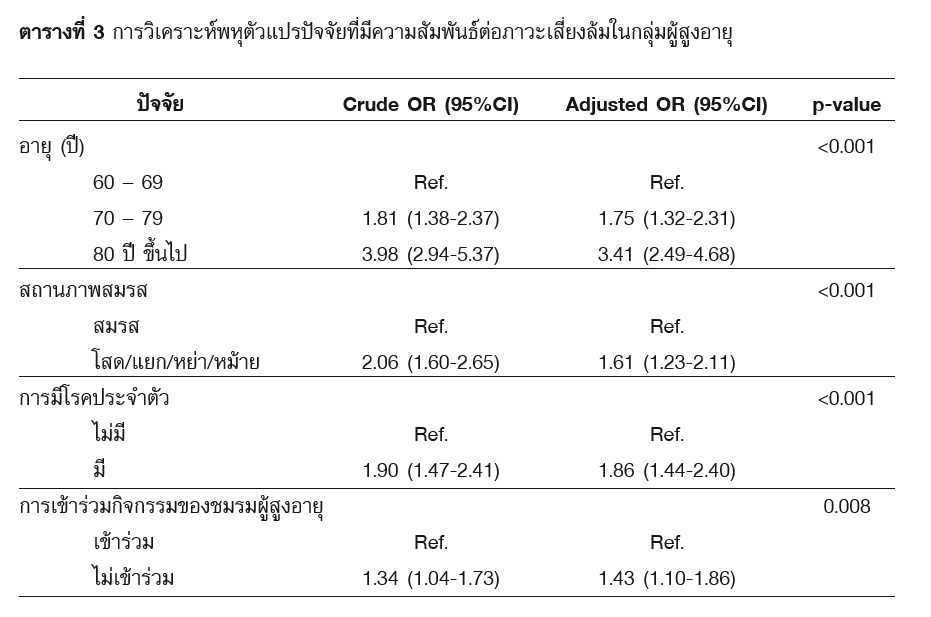PREVALENCE OF FALL RISK AND FACTORS ASSOCIATED WITH FALL RISK AMONG ELDERLY PEOPLE
Main Article Content
Abstract
วัตถุประสงค์ : เพื่อศึกษาเชิงวิเคราะห์ภาคตัดขวางเกี่ยวกับความชุกของภาวะเสี่ยงล้มและปัจจัยที่มีความสัมพันธ์ต่อภาวะเสี่ยงล้มในกลุ่มผู้สูงอายุ
วิธีดำเนินการวิจัย : ทำการศึกษาในกลุ่มประชากรผู้สูงอายุที่มีอายุ 60 ปี ขึ้นไปที่ขึ้นทะเบียนในโรงพยาบาลส่งเสริมสุขภาพตำบล จำนวน 1,636 คน ใน 2 พื้นที่ตำบล อำเภอป่าพะยอม จังหวัดพัทลุง ระหว่างเดือนมีนาคมถึงเมษายน พ.ศ. 2561 ตัวแปรตาม คือภาวะเสี่ยงล้ม ทำการประเมินภาวะเสี่ยงล้มด้วยแบบคัดกรองภาวะเสี่ยงล้ม (Timed Up and Go Test:TUGT) วิเคราะห์ข้อมูลความชุกของภาวะเสี่ยงล้มด้วยสถิติเชิงพรรณนา และวิเคราะห์ปัจจัยที่มีความสัมพันธ์ต่อภาวะเสี่ยงล้มด้วยสถิติถดถอยพหุคูณโลจิสติก
ผลการวิจัย : ความชุกของภาวะเสี่ยงล้มในกลุ่มผู้สูงอายุเท่ากับร้อยละ 23.72 (95%CI: 21.67-25.85) ปัจจัยที่มีความสัมพันธ์ต่อภาวะเสี่ยงล้มในกลุ่มผู้อายุ พบว่า ปัจจัยด้านอายุ สถานภาพ การมีโรคประจำตัวและการเข้าร่วมกิจกรรมในชมรมผู้สูงอายุมีความ สัมพันธ์ต่อภาวะเสี่ยงล้มในกลุ่มผุ้สูงอายุอย่างมีนัยสำคัญทางสถิติ โดยที่ผู้สูงอายุที่มีอายุระหว่าง 70-79 ปี มีโอกาสเสี่ยงต่อภาวะเสี่ยงล้ม 1.75 เท่า (ORadj=1.75,95%CI: 1.32-2.31) และผู้สูงอายุที่มีอายุ 80 ปี ขึ้นไป มีโอกาสเสี่ยงต่อภาวะเสี่ยงล้ม 3.41 เท่า(ORadj=3.41, 9%CI: 2.49-4.68) เมื่อเปรียบเทียบกับ ผู้สูงอายุที่มีอายุระหว่าง 60-69 ปี ส่วนปัจจัยผู้สูงอายุที่มีสภานภาพโสด/แยก/หย่า/หม้ายมีโอกาสเสี่ยงต่อ ภาวะเสี่ยงล้ม 1.61 เท่า (ORadj=1.61, 95%CI: 1.23-2.40) เมื่อเปรียบเทียบกับผู้สูงอายุที่มีสถานภาพสมรส ผู้สูงอายุที่มีโรคประจำตัวมีโอกาสเสี่ยงต่อภาวะเสี่ยงล้ม1.86 เท่า (ORadj=1.86, 95%CI: 1.44-2.40) เมื่อ เปรียบเทียบกับผู้สูงอายุไม่มีโรคประจำตัว และผู้สูงอายุที่ไม่เข้าร่วมกิจกรรมของชมรมผู้สูงอายุมีโอกาส เสี่ยงต่อภาวะเสี่ยงล้ม 1.43 เท่า (ORadj=1.43, 95%CI: 1.10-1.86) เมื่อเปรียบเทียบกับผู้สูงอายุที่เข้าร่วม กิจกรรมของชมรมผู้สูงอายุ
สรุปผลการวิจัย : บุคลากรสาธารณสุขควรส่งเสริมและจัดกิจกรรมส่งเสริมสุขภาพทางกายที่เน้นการ พัฒนาความสามารถในการทรงตัวเพื่อเป็นการป้องกันภาวะเสี่ยงล้มในกลุ่มผู้สูงอายุต่อไป
Article Details
References
Akeplakorn, V., Popakkam, Y., Tanipanichsakul, S., Pakchareon, H., Sateiannopkaow, V. and Thaikla, K., (2010). Report of the 4th health survey of the Thai population by physical examination 2008-2009. Nonthaburi: The Graphico System Company Ltd.
Boonyarat, Y. (2018). Fall prevention for older adults in community by patients centered. Lampang Medical Journal 39(1): 41-43.
Bureau of Policy and Strategy, Ministry of Public Health. (2019). Public health statistics AD 2015. Bangkok: Sam ChareonPanich Ltd.
Centers for Disease Control and Prevention (CDC). (2019). Home and recreational safety: Older adult falls. Retrieved from August 15, 2019. https: //www.cdc.gov/injury/wisqars/index.html.
Ciprandi, D., Bertozzi, F., Zago, M., Sforza, C. and Galvani, C. (2018). Associations between objectively measured physical activity levels and physical fitness and health-related quality of life in elderly women. Sport Sciences for Health 14(1), 183-191.
Cohen, J. (1988). Statiscal Power Analysis for the Behavioral Sciences. 2nd Edition. Hallsdale, New Jersey: Lawrence Erlbaum Associates Publishers.
Department of Disease Control, Ministry of Public Health. (2019). Annual epidemiology surveillance report 2015: Unintenti and falls. Retrieved from July 5, 2019. http: //www.boe.moph.go.th
Department of Medical Service, Ministry of Public Health. (2015). Manual of evaluation and screening older adults. Bangkok: War Veterans Organization Office of Printing Mill.
Duncan, PW., Weiner, DK., Chandler, J. and Studenski, S. (1990). Functional reach: a new clinical measure of balance. Journal of Gerontology 45(6): M192-197
Hanjangsith, K. (1993). Incidence and factors associated with home accidents among older people in Yasothon Province. Bangkok: Mahidol University.
Hausdorff, JM., Rios, DA. and Edelberg HK. (2001). Gait variability and fall risk in community-living older adults: a 1-year prospective study. Archives Physical Medical Rehabilitation 82(8): 1050-1056.
Hsieh, FY., Bloch, DA. and Larson, MD. (1998). A simple method of sample size calculation for linear and logistic regression. Statistics in Medicine 17(14): 1623-1634.
Jitapankul, S. (2001). Principle of Geratric Medicine. Bangkok: Chulalongkorn University Printing House.
Junwang, W. (2015). Falls in Thai older persons. Master of Arts in Demography. Collage of Population Studies: Chulalongkorn University.
Kantayaporn C. (2012). Fall with and without fracture in elderly: what’s different? Journal of Medicine Association of Thailand 95(Suppl. 10): S109-S112.
Limpawattana, P., Sutra, S., Thavornpitak, Y., Chindaprasirt, J. and Mairieng, P. (2012). Geriatric hospitalizations due to fall-related injuries. Journal of The Medical Association of Thailand 95(7): S235-S239.
Ministry of Public Health. (2019). Health Data Center: HDC. January 31, 2019. http: //hdcservice.moph.go.th.
Muangsiri, K., Maharachpong, N. and Rodjarkpai, Y. (2017).Factors relating the behavior of fall prevention among elderly in Chonburi Province. Naresuan University Journal: Science and Technology 25(4): 23-33.
National Statistical Office. (2018). Survey of aging population in Thailand BE 2560. May 21, 2018. Retrieved from http: //www.nso.go.th/sites/2014/Pages/News/2561/N10-07-61.aspx?fbclid=IwAR3VA2SN0V24x9wQHF4kYo _ f hyNJwynGoOCl5U98O3BI7mRUcs1g3r-UANk
Polrith, T. (1998). Factors associated with home accidents among older people between member and non-member of elderly club in Ratchaburi Province. Central Primary Health Care Journal 13(4): 27-37.
Rongmuang, D., Nakchattri, C., Tongdee, J. and Sombutboon, J. (2016). Incidence and factors associated with fall among the community-dwelling elderly, Suratthani. Journal of Prapokklao Nursing College 27(1): 123-138.
Rubenstein, LZ. (2019). Falls and Balance Problems. Patient Education Forum, American Geriatrics Society. Retrieved from August 15, 2019. http: //www.americangeriatrics.org/education/forum/falling.shtml.
Sihapanya, V. (2018). Association between osteoarthritis of knee and risk of fall among older adult. Srinagarind Medical Journal 33(Suppl): 57.
Sorysang, L., Khompraya, J. and Natetanasombut, K. (2014). A study of fall prevention guidelines in older adults living in mitraphappatana community. Journal of The Royal Thai Army Nurses 15(1): 122-129.
Sricom, P. (2014). Predicting factors to fall in older persons with parkinson’s disease. Master’s Thesis. Faculty of Nursing, Chulalongkorn University. Bangkok.
Sturnieks, DL., St. George, R. and Lord, SR. (2008). Balance disorders in the elderly. Neurophysiology Clinique 38(6): 467-478. Doi: 10.1016/j.neucli.2008.09.001.
Thiamwong, L. and Petsirasan, R. (2009). Intrinsic risk factors of falls among Thai older adults in the long-term institutional care. Thai Journal of Nursing Council 24(1): 77-87.
Tinetti, ME., Speechley, M. and Ginter, SF. (1988). Risk factors for falls among elderly persons living in the community.New England Journal of Medicine 319(26):1701-1707.
Woradet, S., Chaimay, B., Songmoung, N. and Sukrat, W. (2020). Prevalence and Factors Associated with Risk of Osteoarthritis among Elderly People in Pa Phayom District of Phatthalung Province. The Southern College Network Journal of Nursing and Public Health 7(1): 277-239.
World Health Organization. (2007). WHO global report on falls prevention in older age. France: WHO Press.
World Health Organization. (2019). Violence and Injury Prevention: Falls. Retrieved from March 1, 2019. http: //www.who.int/violence_injury_prevention/other_injury/falls/en/.


